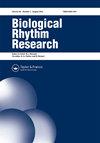Impact of training-shift change on chronotype and social jetlag: a longitudinal study on dancers
IF 0.9
4区 生物学
Q3 BIOLOGY
引用次数: 0
Abstract
ABSTRACT Variations in circadian phase are expected after extreme changes of regular schedules. We took advantage of a real-life model of dance students to address the influence of social pressures on chronotype and sleep patterns in a paired longitudinal study. Seventeen dancers (18–27 years old) being trained at the Uruguayan national dance school ENFA-SODRE switched from training in the night shift in 2019 to the morning shift in 2021 and were evaluated using the Munich Chronotype Questionnaire. Dancers showed a significant advance in their chronotype (07:08 ± 01:39 to 05:12 ± 00:56, p = 0.043) and a significant increase in social jetlag (1.71 ± 1.05 to 2.46 ± 0.80, p = 0.027), while sleep duration fell within the recommended range for the age in both the night shift and the morning shift. The change in chronotype is correlated with the change in social disruption (n = 12, p = 0.038, R2 = 0.36). Dancers alternately used the strategy of oversleeping on free days (associated with higher SJL) or advancing their chronotype (with slight or no change in SJL). Analyzing the effects at the individual level, we were able to highlight the plasticity of the circadian system to cope with the impact of the morning training schedule within non-sedentary late young adults who abruptly, but permanently, changed the timing of their dance training.训练轮班变化对舞蹈演员时型和社会时差的影响:一项纵向研究
本文章由计算机程序翻译,如有差异,请以英文原文为准。
求助全文
约1分钟内获得全文
求助全文
来源期刊

Biological Rhythm Research
生物-生理学
CiteScore
3.00
自引率
9.10%
发文量
34
审稿时长
6-12 weeks
期刊介绍:
The principal aim of Biological Rhythm Research is to cover any aspect of research into the broad topic of biological rhythms. The area covered can range from studies at the genetic or molecular level to those of behavioural or clinical topics. It can also include ultradian, circadian, infradian or annual rhythms. In this way, the Editorial Board tries to stimulate interdisciplinary rhythm research. Such an aim reflects not only the similarity of the methods used in different fields of chronobiology, but also the fact that many influences that exert controlling or masking effects are common. Amongst the controlling factors, attention is paid to the effects of climate change on living organisms. So, papers dealing with biometeorological aspects can also be submitted.
The Journal publishes original scientific research papers, review papers, short notes on research in progress, book reviews and summaries of activities, symposia and congresses of national and international organizations dealing with rhythmic phenomena.
 求助内容:
求助内容: 应助结果提醒方式:
应助结果提醒方式:


